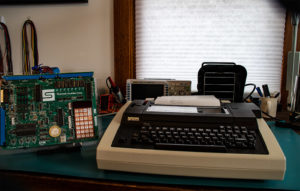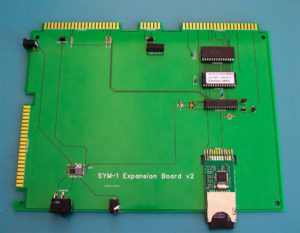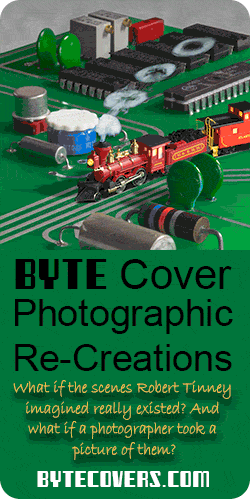
With tech from the 2020s, I dragged a SYM-1 kicking and screaming into the 1980s so that it could play a game from the 1970s.
 I was using 8 bit computers back in the ’70s, and I paid my dues. But these days I’m too old to put up with assembly language or loading programs from tape. So when I bought a SYM-1, I designed an expansion board that added 32K of RAM, 32K of ROM (although not all of it is mapped into the 6502’s memory space) that included BASIC, an assembler, and a DOS, and a modern emulator board for the Commodore 1541 disk drive that I bought from The Future Was 8 Bit.
I was using 8 bit computers back in the ’70s, and I paid my dues. But these days I’m too old to put up with assembly language or loading programs from tape. So when I bought a SYM-1, I designed an expansion board that added 32K of RAM, 32K of ROM (although not all of it is mapped into the 6502’s memory space) that included BASIC, an assembler, and a DOS, and a modern emulator board for the Commodore 1541 disk drive that I bought from The Future Was 8 Bit.
The SYM-1 came with space to plug in ROMs with BASIC, an assembler, and more. But the sockets were designed specifically for ROM chips, not PROMs (programmable ROMs) or anything newer. So I had the options of altering the SYM-1 (not something I want to risk with vintage hardware), plugging in PROMs via an adapter board (which would look ugly), or making a neat expansion board that would sit underneath the SYM-1. Which, obviously, is what I ended up doing.
I could just use my PC and a USB-to-RS-232 interface cable to talk to the SYM, but that’s too modern. I could buy a vintage dumb CRT terminal, but the experience is too similar to using my PC’s computer screen. So I bought a DECwriter. Alas, it’s not a classic DECwriter II, which was probably the most famous hardcopy terminal after the Teletype ASR-33. Instead, it’s the DECwriter Correspondent, a portable terminal with a built-in acoustic coupler modem, from 1986. But it’s still a noisy dot matrix terminal, and that’s what counts.
Classic hardware deserves classic software. And one of the most classic games is the original Star Trek computer game. Check it out:

